|
The
Bully, the Bullied, and the Bystander
By Barbara Coloroso
Reviewed by Michael Reist
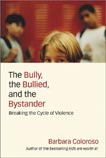 For
Americans it was Littleton, Colorado. For Canadians it was Tabor, Alberta.
During the spring of 1999, the issue of school bullying came out in the
open when bullied students turned into bullies with guns. For
Americans it was Littleton, Colorado. For Canadians it was Tabor, Alberta.
During the spring of 1999, the issue of school bullying came out in the
open when bullied students turned into bullies with guns.
In her most recent book, Barbara Coloroso gives her perspective on the
bullying problem and offers helpful remedies. She makes the point that
too often bullies are simply punished. No attempt is made to get at their
feelings. These feelings, in fact, are usually the driving force behind
the bully's hurtful actions. Bullying is a symptom not a disease, and
we need to address the causes if we're going to stop it.
Coloroso is very critical of the zero-tolerance approach. She calls it
a "zero-thinking" approach, punitive sometimes to the point
of absurdity. She cites the example of the girl who was suspended because
she brought her mother's lunch to school by mistake and it contained a
plastic knife. Zero tolerance is easy to administer because it doesn't
require all the time and "messiness" of getting involved in
a child's emotional life.
We live in a culture that promotes bullying. We see it in politics, sports,
entertainment and business. Many parents, as well as teachers and administrators,
use bullying tactics. As Coloroso puts it, "bullies learn to be bullies
in large part by the way they were treated by bigger or more powerful
people in their lives." A strong sense of self is the best insurance
policy against bullying. As with so many issues involving children and
teenagers, the causes and the methods of prevention go back to the earliest
years.
Bullying happens in every school - much of it unseen by teachers. Coloroso
reminds adult readers that it is their responsibility to take care of
children and this means being proactive. Don't wait until bullying becomes
an issue. Learn about it and talk about it first in order to prevent it.
The Bully, the Bullied, and the Bystander; New York, 2002; ISBN: 0-00-200648-0;
Hardcover, 218 pages, $34.95; Harper Collins; 212-207-7000; www.harpercollins.com
Michael Reist is Head of English at Robert F. Hall Catholic Secondary
School in Caledon East.
Moving
On Made Easier
By
Brenda Whaley and Neil Faba
Reviewed by Helen Dolik
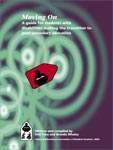 High
shool students with disabilities making the transition to postsecondary
education get a boost from this unique book. High
shool students with disabilities making the transition to postsecondary
education get a boost from this unique book.
A blind high school student wants to attend university and needs help
getting around campus. Who does she turn to? A student with a learning
disability in Québec wonders what scholarships are available in
his province. Who does he contact?
A new book, Moving On, provides a complete guide for high school students
with disabilities making the transition to postsecondary education. All
they have to do now is flip through the user-friendly 137-page book or
click on the web site www.neads.ca/movingon/index.html
for the online version to get information.
Brenda Whaley co-authored Moving On with colleague Neil Faba. The book
is edited by Frank Smith, executive director of the National Educational
Association of Disabled Students (NEADS) while Chris Gaulin designed the
web version.
"This book is a wonderful resource," says Whaley, a Mount Allison
University graduate. "There are so many things we've presented in
it. I would have loved to have it when I was at school. Students with
disabilities really need to know where the resources are because there's
a lot available for them."
Whaley has a passion for helping students with disabilities and has been
involved in the disability field for the past six years.
The book contains information about national funding and scholarship programs,
transition programs for students with disabilities, federal programs for
students, national non-governmental organizations and a section on disability
student groups on campuses. The book is further divided into sections
to provide provincial resources. It also provides a frequently asked questions
section and student success stories. Many people were consulted about
the book, including asking high school students directly what they wanted
in the guide.
The book was funded by the Social Development Partnerships Program of
Human Resources Development Canada.
Whaley also co-authored another NEADS' publication called Faculty Awareness
and Training in the Post-Secondary Community: An Annotated Bibliography.
Moving On can be downloaded from www.neads.ca/movingon/index.html.
For a printed copy contact the NEADS office at 613-526-8008.
The
Care and Education of Young Bilinguals: An Introduction for Professionals
By Colin Baker in
association with Anne Sienkewizc
Reviewed by Helen Donohoe
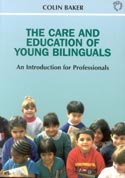 This
text provides a very comprehensive survey of the situation facing students
who operate, to varying degrees, in more than one language. The writer
is a Welshman who has played a role in bilingual Welsh/English education
and he examines every possible aspect of monolinguism, bilingualism and
multilinguism. This
text provides a very comprehensive survey of the situation facing students
who operate, to varying degrees, in more than one language. The writer
is a Welshman who has played a role in bilingual Welsh/English education
and he examines every possible aspect of monolinguism, bilingualism and
multilinguism.
The approach is global-there are frequent references to Canada. It is
entirely applicable to our schools, where the population is among the
world's most diverse and provides us with the tools to create a linguistic
profile of our students.
As the world's population becomes more mobile, linguistic configurations
multiply.
The monolingual teacher is challenged to think of the state of monolingualism
as something other than the point of reference and for the anglophone
teacher who functions entirely in English, this is not easy.
This aptly titled text supplies the definitions to encourage schools to
go beyond the acronym ESL and to create specific linguistic profiles of
the student body. This is a text that belongs in the professional section
of all school libraries.
The Care and Education of Young Bilinguals. NY, 2001; ISBN 1-85358-465-2;
softcover, 200 pages, $19.95; Multilingual Matters; 44 (0) 1275 876519;
fax 44 (0) 1275 871673; www.multilingual-matters.com
Helen Donohoe teaches at Sanford Avenue School in Hamilton.
10
Best Teaching Practices: How Brain Research, Learning Styles, and Standards
Define Teaching Competencies
By
Donna Walker Tileston
Reviewed by Marjan Glavac
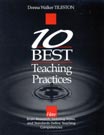 How
can a school with low test scores, a high dropout rate and many discipline
problems be turned around to enjoy the highest test scores in the state,
low incidences of discipline problems and sustain these results? Teacher,
author and consultant Donna Walker Tileston believes any school can accomplish
this task through the use of 10 best teaching practices. How
can a school with low test scores, a high dropout rate and many discipline
problems be turned around to enjoy the highest test scores in the state,
low incidences of discipline problems and sustain these results? Teacher,
author and consultant Donna Walker Tileston believes any school can accomplish
this task through the use of 10 best teaching practices.
Each chapter in her book 10 Best Teaching Practices focuses on a teaching
practice essential to make an impact on student learning and provides
at the end of each chapter a handy chart with assessment tools and indicators
of success for each teaching strategy.
This book provides a good overview of each of the teaching practices that
Tileston has chosen to highlight but, being only 83 pages in length, lacks
the necessary depth to examine each in detail. When only four pages are
devoted to "bridging the gap between all learners, regardless of
race, socioeconomic status, sex or creed," and only three pages are
devoted to promoting real-world application of learning, there's ample
room to expand this book.
10 Best Teaching Practices; Thousand Oaks, CA, 2000; ISBN 0-7619-7585-3;
softcover, 83 pages, US$27.95; Corwin Press; 805-499-9734; Toll free fax:
800-4-1-SCHOOL; www.corwinpress.com
Marjan Glavac is a Grade 5 teacher at Wilfrid Jury Public School in
London.
Chicken
Soup for the Teacher's Soul: Stories to Open the Hearts and Rekindle the
Spirits of Educators
By
Jack Canfield & Mark Victor Hanson
Reviewed by Quentin D'Souza
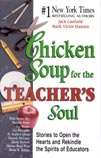 Chicken
Soup for the Teacher's Soul is a heartwarming book that shows how educators
change the lives of their students. It is written from a wide range of
perspectives. Teachers, counselors, administrators, educational consultants,
coaches and former students from preschool to university have all contributed
their stories in this volume. Chicken
Soup for the Teacher's Soul is a heartwarming book that shows how educators
change the lives of their students. It is written from a wide range of
perspectives. Teachers, counselors, administrators, educational consultants,
coaches and former students from preschool to university have all contributed
their stories in this volume.
Each of the 11 headings covers a different part of an educator's life.
The sections contain short stories-only a few pages long-that both entertain
and motivate. Many of the stories begin with a beautiful quote that sets
the tone of the narrative. Cartoons scattered through the book add a touch
of humour.
A story, quote or cartoon would be great to start a staff meeting, workshop
or provide some inspiration to a colleague. This book is excellent reading
when you need a pick-me-up, especially if you are wondering what effect
you can have on those you teach. Chicken Soup for the Teacher's Soul is
the perfect book for an educator's bedside table.
Chicken Soup for the Teacher's Soul; Deerfield Beach, FL, 2002; ISBN 1-55874-978-0;
softcover, 385 pages, $21.95; Health Communications Inc. 3201 S.W. 15th
Street, Deerfield Beach, FL, 33442-8190; Available through www.Amazon.com;
www.chapters.indigo.ca and other bookstores.
Quentin D'Souza teaches Grade 8 at The Divine Infant Catholic School
in Toronto.
|
![]()
